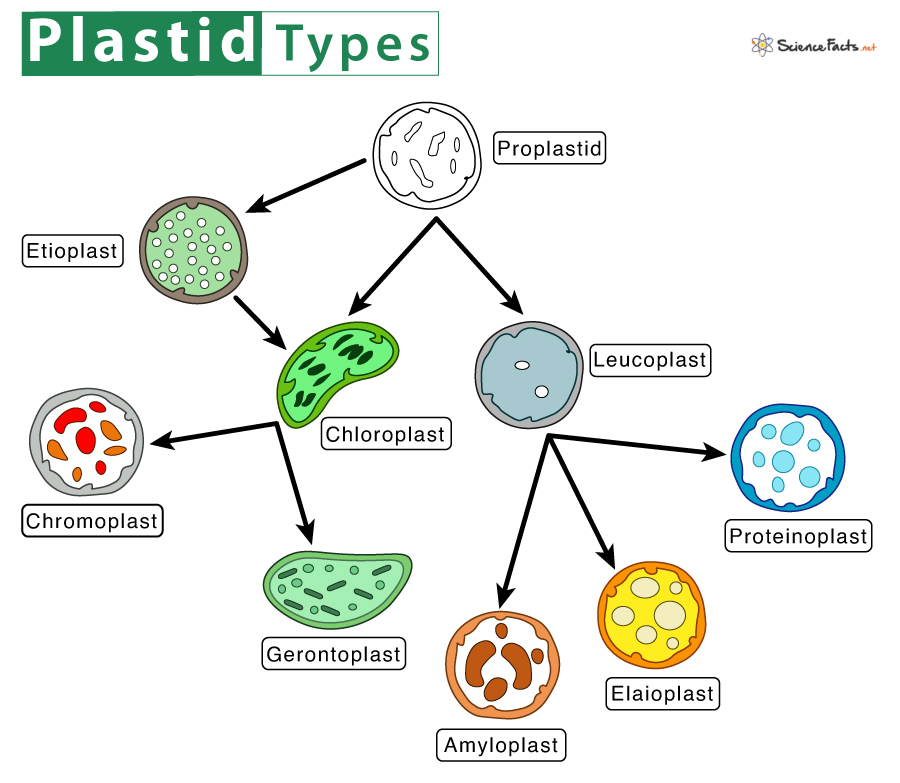Plastids
What are Plastids
Plastids are a group of double membrane-bound organelle found in almost all types of cells in plants and algae, and also in some other higher organisms.
They were discovered and named by Ernst Haeckel, while A. F. W. Schimper was the first to define plastids.
Origin
They are thought to have been originated from a group of free-living photosynthetic bacteria known as cyanobacteria that live within other host organisms.
Structure
Depending on the species of plant and algae, plastids may take up a variety of shapes ranging from discoid, spherical, dumbbell-shaped, or lens-shaped among a few others.
Parts
1. Double Membrane: Outer and inner membrane with a thickness of 7 nm each and consisting of phospholipid molecules
2. Intermembrane Space: Present within two membranes with (8-10) nm thickness
3. Grana: Stacks of membrane-bound organelle called thylakoid. Each granum contains approximately 10-20 thylakoids
4. Stroma: Cytoplasm of the organelle containing proteins, enzymes, and ribosomes
5. Peripheral Reticulum: Membranous tubules arising from the inner membrane
6. DNA: Genetic material of plastids
7. Ribosome: Organelle where protein synthesis occurs
Different Types of Plastids with Examples
1) Proplastids: Colorless and immature plastids that develop into any mature plastid, depending on the organ where they function. Proplastids are always in a state of active division. They later develop into chloroplast or leucoplast.
2) Chloroplasts: Present in all the green parts of the plant, and blue-green algae. They are green in color due to the presence of the pigment chlorophyll.
3) Leucoplasts: Non-pigmented organelles that are colorless and are found in the endosperm of seed, roots, and other non-photosynthetic plant parts. Based on the kind of food they store, leucoplasts are classified into the following 3 types:
- Amyloplasts
- Proteinoplasts
- Elaioplasts
4) Etioplasts: They are chloroplasts that have not been exposed to light and are a transitional stage between the proplastid and the chloroplast during the process of greening.
5) Chromoplasts: Present in flowering plants, aging leaves, and fruits. They are colored plastids assuming different colors that develop gradually from chloroplasts with time.
6) Gerontoplasts: They are chloroplasts that are going through the aging process. Gerontoplasts are present in the old leaves that are no longer performing photosynthesis.
Functions
- Chloroplasts help in synthesizing food by the process of photosynthesis
- Chromoplasts attracts pollinators and thus helps in pollination
- Gerontoplasts helps in breaking down the photosynthetic apparatus during plant cell death
- Amyloplasts stores starch
- Proteinoplasts stores protein
- Elaioplasts stores fat and oil
FAQs
Ans. Animal cells do not have a plastid.
Ans. Plastids contain DNA as large protein-DNA complexes called plastid nucleoids, which are found to be associated with the inner mitochondrial membrane.
Ans. Mitochondria and Plastids are two different cellular organelles that are found together only in a plant cell or algae.
-
References
Article was last reviewed on Friday, February 3, 2023




